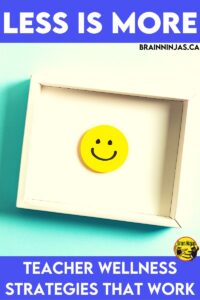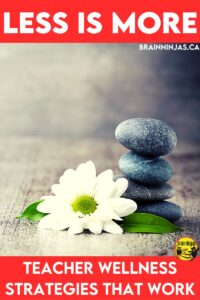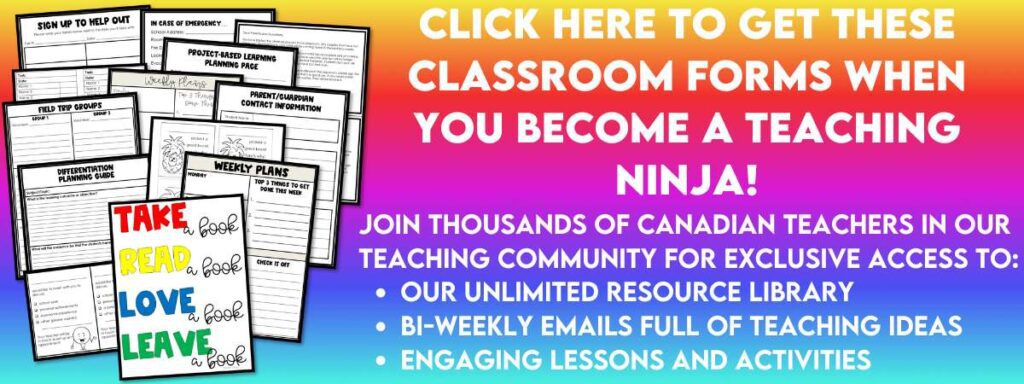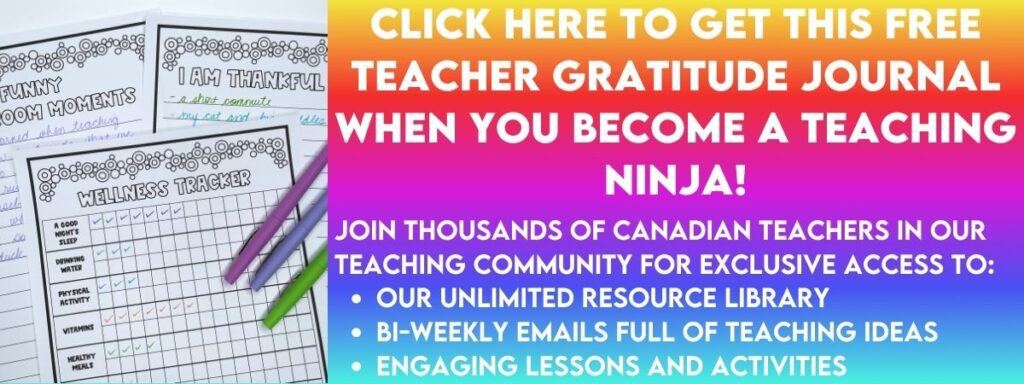
Sometimes it feels like teachers are stretched so thin. Teacher wellness strategies are buzzwords, but what does it mean to you?
It’s impossible to do it all. That is when the guilt sets in. It feels like we should be able to do more, but maybe the trick is to do less? Of course, in a perfect world teachers would have input into making these decisions, but a girl can dream, right?
So, what are some ways we do less so that we can experience more? Check out these teacher wellness strategies to balance your mental health with the career you love.
Less Content

Less content would mean deeper understanding. We could take the time to discuss issues that are connected to students’ real lives and make sure students understand rather than memorize. We could get deep into the material.
Sometimes it’s easy to get bogged in how much material there is to cover. Teachers are given a list of all the things students need to understand, explain, be able to do or appreciate.
It can be very overwhelming, especially for a new teacher who hasn’t mastered all the content to learn, break down and teach each little detail.
How to Deal With It
Start with the big ideas.
Think about the big thing all people need to understand about a concept. For example, if students are required to understand the technology used in World War 2 by the Allies, have students look at different vehicles and weapons from that time and have them compare them to vehicles and weapons from a much earlier war. Simply looking at photographs can help students understand the big concepts that technology changes how wars are fought. It’s one big idea, but students do not need to know every type of vehicle or weapon to grasp the big idea.
Teach the most important outcomes first.
Basic skills like reading and computation will help students develop other skills like researching and problem-solving. It’s a little like teaching your students to walk before you can teach them to run.
Integrate outcomes or subject areas.
If you’re learning research skills and have to learn about The Great Migration, research The Great Migration. Make connections wherever possible.
Less Students

Fewer bodies in a classroom would mean more one one-on-one instruction and more time with each student. Lessons could be better tailored to student needs regardless of their learning style.
How to Deal With It
Organize Small Groups
You aren’t going to be able to remove students from your room, but you can reach more of your students by organizing your room with guided math, writing or reading in small groups. This style of teaching requires strong classroom management, so if you want to brush up read our blog post: The Reasons Your Classroom Management Isn’t Working and How to Fix It.
Teach Independence
Have students learn to work independently on tasks they can manage. Teach them what to do if they get stuck while you’re working with a student.
We wrote an entire blog post to help you set up your classroom to work toward independence. Read: Help! What Should the Other Groups Do During Guided Reading? It has practical suggestions to help your students get organized and work independently.
If you’re struggling with students overwhelming you with questions, try reading: Are You Accidentally Teaching Helplessness?
Plan Ahead
Plan ahead so you can maximize your class time and use unstructured times like recess breaks to chat with students to build rapport. We use Learner Profiles and Surveys to help interview students. Find them in our TpT Store ($USD) and our BN Shop ($CAN).
Plan out your whole week in advance. We plan Tuesday to Tuesday so that we don’t spend our weekends planning. Be sure to keep track of school events so that you are cut short in your instructional minutes.
Free planning pages can be found in our Resource Library, along with many other general classroom forms to help you organize your classroom, or we can send them to you when you join our ninja mailing list.
Less Paperwork
Less paperwork would mean more time for planning or personal time in the out of school hours. Personal time is important. It is what keeps us healthy. We are not talking about the usual report cards, but does it need to be a five-page document when we talk to these same parents on a regular basis? Is it the best use of our time?
How to Deal With It
Be Organized.
Knowing what paperwork is due, what its purpose is and what is expected will go a long way in helping you get it all done. Use a schedule or plan out how long you think it will take. Ask other teachers how long it takes so you can allot enough time.
You might benefit from reading: Clean the Clutter.
Do it.
When it’s time to get the paperwork done, sit down and knock it out. Or, pair up with your grade-level partner and write these documents together. This also serves well for consistency, but if your partner is chatty, it might be faster to work alone.
It takes longer to get it done when you procrastinate, so just be a grown-up and get it done.

Don’t Reinvent the Wheel.
Creating a bank of comments that you can reuse can save you time. We usually keep a Google Document full of comments we can use on report cards, parent communication and special needs documents like individual programs or education plans. After a while, you’ll have statements for nearly any situation.
Sometimes these forms or documents can be passed along from year to year and the information updated. Check to see what is already available or done so you don’t have to create the document from scratch.
Less Extra Stuff
The Things That Are Hard to Avoid
Duties like supervision or meetings that are assigned by your principal are hard to avoid. Unfortunately, these are things you just have to do. Make it less painful by yourself by being on time and getting the job done.
The Stuff You Can Decide On
Running extracurricular clubs or teams is usually optional (though almost everyone is asked to take one or two each year). Less time coaching and supervising these clubs or teams would mean more time off from school-related activities (aka personal time). Balancing work and personal time creates healthier teachers in general. Choosing to take part in these activities would create more buy-in rather than being forced to do them.
How to Deal With It
Take on What You Enjoy
Volunteer for what you can do well or what you enjoy doing. Be a good team member, by only speaking up at meetings when necessary or helping to streamline tasks. Pick the clubs or teams you like to do and then politely decline all the other things due to your dedication and time commitment to those activities.
Choose the Things You Can Do in Less Time
If you can do a task faster than someone else, it might be wise to choose that (and then just keep the amount of time to yourself) because you can do it very efficiently.
More Hands Are Less Work (Sometimes)
If everyone does a little, it gets done more efficiently and isn’t that better for everyone? When you are working with like-minded and agreeable individuals more help is great. If you find you are working with people who can’t make decisions, get the job done or complain the whole time, take note and do your best to avoid these people in the future.
Less Parenting

Our students spend the majority of their day with us and for some students that means more than they see their parents or guardians. Not spending time teaching things (like hygiene, manners, or social situations) that traditionally have been taught by parents would mean more time teaching content areas.
We spend so much of our day being role models, nurses, disciplinarians, caregivers and social workers that teaching sometimes comes second to all of that because it needs to.
How to Deal With It
Be a Safe Space
It can be challenging being everything to everyone, but for some of the children who come through our doors, we are the best part of the day. We have to remember we are there to teach the whole child, even if that means feeding, teaching and caring for one. Be grateful that you can make a difference when some days it feels like it takes your everything and the math doesn’t get done.
Teach Students to Self-Regulate
This is a skill that some students need help with to learn. Read all about it: How to Teach Your Students to Self-Regulate.
Access Resources
Talk to your staff members about what resources might be available to students or their families. We often miss out on opportunities simply by not knowing they exist.
Think of Maslow’s Hierarchy of Needs
A student that hasn’t been fed or doesn’t feel safe at school isn’t going to learn anything regardless of how amazing your lesson plan is. Take the time to build a relationship and make all your students feel that your classroom is a safe place for them. Read more about Maslow’s Hierarchy of Needs.
Less Guilt
This is one that so many teachers and women in general struggle with. When we dedicate our time to our classroom we feel guilty for neglecting our friends and family. When we spend time with our friends and family we feel guilty that we aren’t able to do everything in the classroom that would. For some reason, we’ve been trained to feel guilty no matter what.
How to Deal With It
Let Go
This is really hard for some people, but let go of the expectations of other people and focus on what you want. Work-life balance is a term created to make people feel like they should be able to balance it all, but it’s not quite true. It’s not about balance. It’s about choices. What do you value and want to spend your time doing? Let everything else go.
Talk to People Who Inspire You
People who drag you down and cloud up your positive mindset need to be set aside. You can do this by ghosting them until they disappear, or you can have a conversation about how their negativity affects you. If they don’t change, then you have to.
Of course, you cannot change your family, but you can refocus your positivity through your own actions whether that’s reading books, listening to music or podcasts, meeting new friends or exercising.
There are many people out there who can lift you up. Avoid the ones that don’t.
Be Comfortable With You
You became a teacher and that didn’t happen because you were lazy or made a poor choice. You can do anything you set your mind to, but if you’re letting the opinions of others decide your life for you, it’s time to get comfortable with what you want. Do not apologize for wanting a career or a family or an active lifestyle or a healthy lifestyle. You do not need to justify your choices.
And you already have goals or dreams. The problem is that most people don’t realize them because they let other people get in the way. Be comfortable with what you want by getting comfortable with others being uncomfortable about it. They’ll just have to get over it.
Do what you need and let everyone else worry about themselves. You can do amazing things. We believe in you.
Be Grateful
Sometimes we just need a reminder that things could be worse. Keep track of the happy memories in your classroom with a simple gratitude journal. You can find it in our Resource Library, or we can send you a copy when you sign up for our email list.
Make a Change
It might be time to be honest with yourself about how unhappy you are in your job. Maybe it’s time for a change. When to Quit Your Teaching Job and Why It’s Ok is all about the possibilities.
All of this “less”-ness would result in better teaching, healthier teachers and an overall stronger education system. What do you think? What else do we need less of in our classrooms? We’d love to hear from you so leave a comment for us below.








